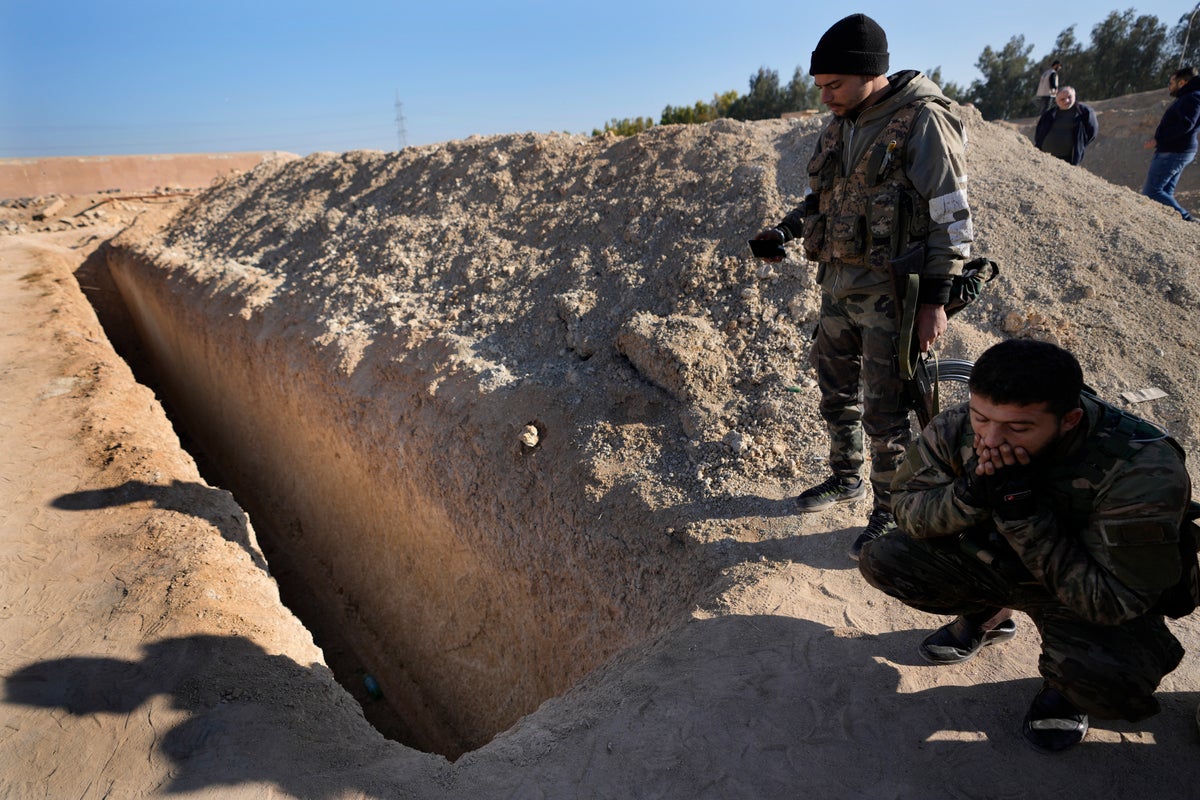
Mounds of bare, turned earth stretch near agricultural fields south of Damascus, one of multiple mass graves around the country believed to hold the bodies of tens of thousands of Syrians killed under Bashar Assad's rule. With his ouster, residents, forensic teams and international groups face what could be a yearslong task of unearthing the dead.
In this site alone, by the town of Najha, several tens of thousands of bodies could have been buried, said Stephen Rapp, a former U.S. ambassador-at-large for war crimes issues who was visiting the site Tuesday. Some are believed buried under already existing graves of a regular cemetery nearby, he said.
It's too soon to start digging, and it's unknown how many bodies remain there or if some were moved over the years. But here and there, bones were visible, including some vertebrae from a human spine and fragments of a femur.
Rapp is working with two organizations that aim to help document mass graves and identify officials implicated in war crimes — the Commission for International Justice and Accountability and the Syria Emergency Task Force. They and other groups have for years been remotely gathering witness testimonies and satellite imagery to track and estimate the size of mass graves that swelled from crackdowns by Assad's feared security agencies, particularly in the early years of Syria's civil war that began in 2011.
With Assad's fall 10 days ago, they are now able to see them firsthand. That gives the chance to "really corroborate what we already know about the machinery of death that was maintained and operated by the Assad regime,” Rapp said.
“It is all so unthinkable that this is happening in the 21st Century.”
More than 150,000 Syrians remain unaccounted for after disappearing into Assad's prisons and most are believed to be in mass graves around the country, said Mounir al-Mustafa, deputy director of the White Helmets, a Syrian search and rescue team.
An array of prisons run by the military, intelligence and security agencies were notorious for systematic torture, mass executions and brutal conditions that killed other inmates from disease and starvation, according to human rights groups, whistle-blowers, and former detainees.
The White Helmets have received reports of at least 13 mass grave sites around the country, eight of them near Damascus, including Najha, al-Mustafa said.
“We can’t open these mass graves yet. That is a massive task to document and take samples and give codes to the corpses before we can identify those people,” he said.
The priority is to take stock of the unidentified bodies above ground, those in hospital morgues and in clashes, al-Mustafa said.
Rapp, who arrived in Syria on Monday, visited another suspected grave site, in al-Qutayfah, 37 kilometers (23 miles) north of the capital. He plans to meet with officials from the new transitional government installed since the lightning offensive on Damascus on Dec. 8 that forced Assad to flee the country. He intends to discuss ways to secure and eventually excavate the sites, gather samples from remains for identification and preserve thousands of documents discovered in many security branches and prisons.
“There needs to be a process. That is what I will be engaging with government representatives about,” Rapp said. He said he will also see what the international community can do to assist the government in criminal prosecutions and in ensuring they meet international standards.
On Monday, residents and medical teams began on their own digging up a mass grave in the village of Izraa in southern Daraa province. The remains of over 30 corpses were uncovered, and the teams estimated the total number could reach 70.
Moussa Al-Zouebi, the head of the village’s health directorate, said some of the people whose remains were uncovered were executed by “shooting in the head, in the eye, or by burning.” A local forensic team and rebel fighters handled bags of human remains as an excavator rumbled in the background, while relatives stood by.
Relatives said they initially had hopes that they would find their loved ones in a prison. “But we didn’t find anyone and it broke our hearts. They were burned alive here after being doused in fuel,” Mohammad Ghazaleh said at the mass grave site.
The new authorities in Damascus have designated a hotline for people and ex-prisoners to identify locations and secret prisons used by Assad’s government to find any trace of missing persons. The insurgents have freed thousands of prisoners in Damascus and other cities, including Aleppo, Homs and Hama.
“It is understandable that the desperate family members will try to go to a site hoping that they find some sign of their relatives, some information,” Rapp said. He said the same is happening with documents found at sites. “Although that is understandable, it can be damaging to an investigation," he said.
Rapp said the process of securing and cataloguing documents could take up to three months but identifying those buried in mass graves could take more than two years.







